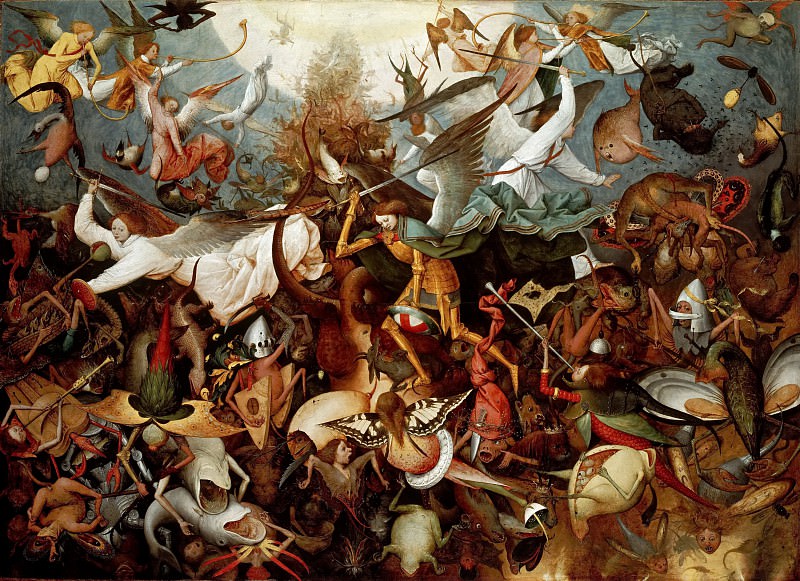The Fall of the Rebel Angels Pieter Brueghel The Elder (1525-1569)
Pieter Brueghel The Elder – The Fall of the Rebel Angels
Edit attribution
Download full size: 4420×3207 px (5,7 Mb)
Painter: Pieter Brueghel The Elder
Location: Royal Museum of Fine Arts (Koninklijke Musea voor Schone Kunsten), Brussels.
The Fall of the Rebellious Angels was painted by Flemish painter Peter Bruegel the Elder in oil on wood in 1562. The subject is based on a biblical story of angels rebelling in pride, symbolically reflecting the end of the world, when humanity, steeped in cruelty and nonsense, would be doomed to perdition. At the center of the painting is the archangel Michael in a blue cloak. He uses a sword with a gold translucent handle to defeat the dragon, which in all likelihood symbolizes Satan. At the top of the image is a glittering ball representing Heaven.
Description of Peter Brueghel the Elder’s painting The Fall of the Rebel Angels
The Fall of the Rebellious Angels was painted by Flemish painter Peter Bruegel the Elder in oil on wood in 1562.
The subject is based on a biblical story of angels rebelling in pride, symbolically reflecting the end of the world, when humanity, steeped in cruelty and nonsense, would be doomed to perdition.
At the center of the painting is the archangel Michael in a blue cloak. He uses a sword with a gold translucent handle to defeat the dragon, which in all likelihood symbolizes Satan.
At the top of the image is a glittering ball representing Heaven. The bright angels fight the dark army of rebels against God and play a hymn of victory on the divine trumpets. The figures here are bright, clear, with detailed faces. The wings are worked out with great virtuosity. The movements are free. The exception is the falling images. Despite their white clothing and golden wings, you can see that they have already fallen and, spreading out their arms, fall down involuntarily.
The lower half of the painting is dark and gloomy, an effort is required to distinguish the individual images. Everything here is mixed, saturated, dense and chaotic. The figures in hell lose their human form and turn into horrible monsters with huge jaws and claws. Faces and eyes that are still distinguishable are filled with horror, mouths open in a mad screech.
The colors of the bottom and top are different. The top is done in blue, blue, yellow, and white hues. The colors are rich, vibrant and luminous. The bottom is filled with dark and ominous colors. The browns, dark reds, toxic yellows, grays, and greens create the impression of a horrible mixture that kills all that is bright and takes life.
The perspective is beautifully worked out in the painting - it is emphasized by the size of the figures - they are large in the foreground and small at the top. The movement is conveyed by the direction of the fall.
The work is in the Royal Museum of Fine Arts, Brussels.
Кому понравилось
Пожалуйста, подождите
На эту операцию может потребоваться несколько секунд.
Информация появится в новом окне,
если открытие новых окон не запрещено в настройках вашего браузера.
You need to login
Для работы с коллекциями – пожалуйста, войдите в аккаунт (open in new window).




















COMMENTS: 2 Ответы
Лучшее творение этого художника, шедевр всех времен
На картине изображена сцена падения ангелов. Восставшие против Бога ангелы падают вниз, в ад. При этом небеса изображены в виде белого круга вверху посередине картины. Архангел Михаил в центре, в голубом плаще. Фигуры в нижней части картины обнажены, превращены в уродливых монстров с животными частями тел. Ад более плотен, хаотичен, тёмен, чем верхняя часть полотна.
You cannot comment Why?